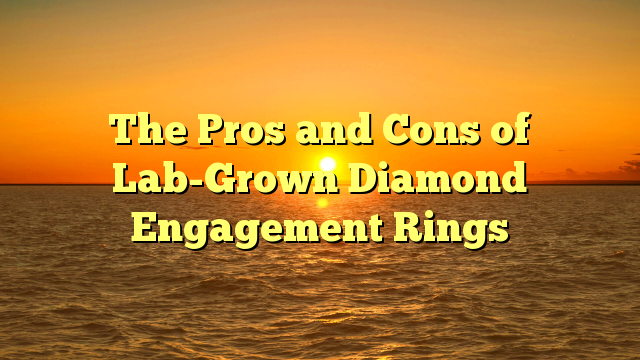The Pros and Cons of Lab-Grown Diamond Engagement Rings
Introduction
Diamonds are a symbol of love, commitment, and eternity. Traditionally, couples choose natural diamonds for their engagement rings, but recently, lab-grown diamonds have gained popularity. Lab-grown diamonds have the same chemical and physical properties as natural diamonds but are created in a controlled environment. In this article, we will discuss the pros and cons of lab-grown diamond engagement rings.
Pros of Lab-Grown Diamond Engagement Rings
1. Cost-effective
Lab-grown diamonds are less expensive than natural diamonds. They can cost up to 30% less than natural diamonds, making them a more affordable option for engagement rings.
2. Ethical
Lab-grown diamonds are created in a controlled environment without any human rights violations or environmental damage. Unlike natural diamonds, lab-grown diamonds do not have a history of conflict or exploitation.
3. Environmentally friendly
Diamond mining can cause significant environmental damage. It requires the removal of tons of earth, leaving behind large holes in the ground. Lab-grown diamonds, on the other hand, are created in a controlled environment, resulting in minimal environmental damage.
4. High-quality
Lab-grown diamonds have the same physical and chemical properties as natural diamonds. They are as durable and hard as natural diamonds and have the same sparkle and brilliance.
5. Consistent quality
Natural diamonds vary in quality and clarity, making it difficult to select a perfect diamond. Lab-grown diamonds, however, are created with consistent quality and clarity, making it easier to find the perfect diamond for your engagement ring.
Cons of Lab-Grown Diamond Engagement Rings
1. Perception
Lab-grown diamonds are a relatively new concept and may not be perceived as valuable as natural diamonds. Natural diamonds have a long history of being the traditional choice for engagement rings, and some people may prefer the traditional option.
2. Resale value
Lab-grown diamonds do not hold their value as well as natural diamonds. Natural diamonds are rare, and their value tends to increase over time. Lab-grown diamonds, however, are more common, and their value may decrease over time.
3. Limited availability
Although lab-grown diamonds are becoming more popular, they are not as widely available as natural diamonds. This limited availability may make it harder to find the perfect diamond for your engagement ring.
4. Limited size
Lab-grown diamonds are currently limited in size. The largest lab-grown diamond is only around 16 carats, while natural diamonds can be much larger.
5. Synthetic origin
Although lab-grown diamonds have the same physical and chemical properties as natural diamonds, some people may not like the idea of a synthetic diamond. They may prefer the idea of a natural diamond formed in the earth over a diamond created in a laboratory.
Conclusion
Choosing between natural and lab-grown diamonds for an engagement ring is a personal choice. It is important to weigh the pros and cons and decide what factors are most important to you. Lab-grown diamonds are a cost-effective, ethical, and environmentally friendly option. However, they may not hold their value as well as natural diamonds and may not be as widely available.
FAQs
1. Are lab-grown diamonds as durable as natural diamonds?
Yes, lab-grown diamonds have the same physical and chemical properties as natural diamonds and are just as durable.
2. Are lab-grown diamonds ethical?
Yes, lab-grown diamonds are ethical. They are created in a controlled environment without any human rights violations or environmental damage.
3. Can lab-grown diamonds be distinguished from natural diamonds?
No, lab-grown diamonds are identical to natural diamonds in terms of their physical and chemical properties, making it nearly impossible to distinguish them without specialized equipment.
4. Are lab-grown diamonds more environmentally friendly than natural diamonds?
Yes, lab-grown diamonds are more environmentally friendly than natural diamonds. Diamond mining can cause significant environmental damage, while lab-grown diamonds are created in a controlled environment with minimal environmental impact.
5. Are lab-grown diamonds a good choice for an engagement ring?
Yes, lab-grown diamonds can be an excellent choice for an engagement ring. They are cost-effective, ethical, and high-quality. However, it ultimately depends on personal preference and what factors are most important to the individual.
6. Will the value of lab-grown diamonds increase over time?
The value of lab-grown diamonds may not increase over time as they are more common and easier to produce than natural diamonds. However, the value may increase as the demand for lab-grown diamonds grows in the future.
7. Can lab-grown diamonds be certified?
Yes, lab-grown diamonds can be certified by reputable organizations such as the Gemological Institute of America (GIA) and the International Gemological Institute (IGI).
8. How are lab-grown diamonds created?
Lab-grown diamonds are created using two methods: High Pressure High Temperature (HPHT) and Chemical Vapor Deposition (CVD). HPHT involves mimicking the high pressure and temperature conditions required to form natural diamonds, while CVD involves depositing carbon vapor onto a substrate to grow the diamond.
9. Can lab-grown diamonds be resized or repaired like natural diamonds?
Yes, lab-grown diamonds can be resized or repaired in the same way as natural diamonds.
10. Are lab-grown diamonds a sustainable choice?
Yes, lab-grown diamonds can be a sustainable choice as they are created in a controlled environment without causing environmental damage or human rights violations. However, it is important to research the specific company and their sustainability practices before making a purchase.



